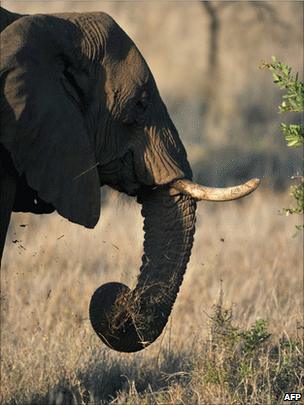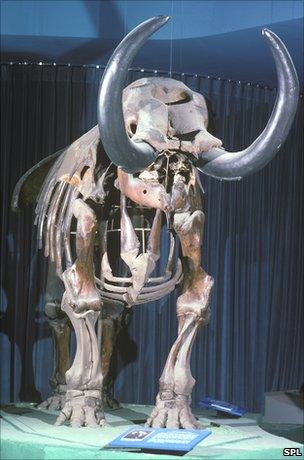African elephant is two species, researchers say
- Published

Poaching is a major concern in parts of Africa - especially of forest elephants
Genetic researchers may have resolved a long-standing dispute by proving there are two species of African elephant.
Savannah and forest elephants have been separated for at least three million years, they say, and are as distinct from each other as Asian elephants are from the extinct woolly mammoth.
The researchers also made what they say are the first sequences of nuclear DNA from the extinct American mastodon.
The study is reported, external in the journal Public Library of Science Biology.
The debate over whether the African elephant is one or two species has been going on for about a decade.
Weighing in at six or seven tonnes, the much larger elephants found on savannah are about twice as heavy as forest-dwellers.
This, along with other differences in size and shape, has led some researchers to conclude there are two species - the savannah (or bush) elephant, Loxodonta africana, and the forest species, Loxodonta cyclotis.
The scientists - from the US, UK and Germany - now say they have proved the case.
"The divergence of the two species took place around the time of the divergence of the Asian elephant and woolly mammoths," said Michi Hofreiter, a specialist in ancient DNA at the UK's York University.
"The split between African savannah and forest elephants is almost as old as the split between humans and chimpanzees. This result amazed us all."
Ancient and modern
The researchers compared sequences of DNA from the nuclei of African and Asian elephants, and from woolly mammoths and the American mastodon.
All are members of the Proboscidea order of mammals.
The mastodon became extinct about 10,000 years ago - around the same time that mammoths disappeared from most of their range.
Although mastodon mitochondrial DNA has been sequenced before, the researchers say they were the first to do the analysis on DNA from the cell nucleus - in this case, using material from a tooth.
"Experimentally, we had a major challenge to extract DNA sequences from two fossils - mammoths and mastodons - and line them up with DNA from modern elephants over hundreds of sections of the genome," said Nadin Rohland of Harvard Medical School.
The genetic "distance" between the Asian elephant and the woolly mammoth turned out to be about the same as between the two African elephant species - which, the researchers say, proves the case for two distinct species in Africa now.
Fragmented world
The picture of elephant conservation across Africa is a mixed one.

The researchers say they have also done the first nuclear genetic analysis of the American mastodon
In southern countries, the animals are thriving, with populations increasing so fast that governments have had to consider culls.
However, the picture is very different in Central and West Africa, where poaching, ivory smuggling and the bushmeat trade are fragmenting populations.
If there are indeed two species, the forest dwellers are the ones most under pressure, as they tend to be found in areas where poaching and smuggling are rife.
Potentially, confirming the separation could help direct conservation efforts where they are most needed, according to Simon Stuart, chair of the International Union for the Conservation of Nature's Species Survival Commission (SSC).
"We'd have to review the evidence to see whether we need to split the African elephant into two entries on the Red List of Threatened Species," he told BBC News.
"Currently the species is listed as Vulnerable but it's possible that if there are two, one would come out in a more serious category and the other in a less serious one.
"This could be helpful for highlighting the Central African issue."
However, he cautioned, other research groups may well challenge the conclusion of the latest study, and the debate may have some way to run.
- Published23 October 2010